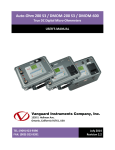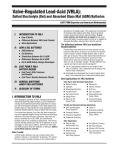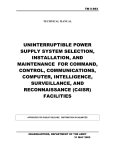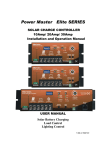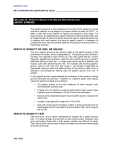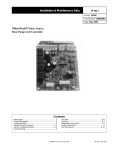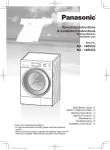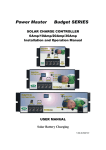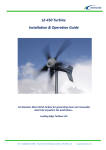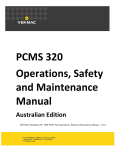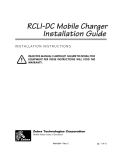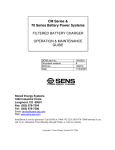Download chapter 5 uninterruptible power supply (ups
Transcript
TM 5-693 CHAPTER 5 UNINTERRUPTIBLE POWER SUPPLY (UPS) SYSTEMS MAINTENANCE PROCEDURES _______________________________________________________ 5-1. Maintenance for UPS systems A general guide for the maintenance requirements of the UPS systems modules, static switches, and controls is provided. Although electronic components are not subject to wear in the same degree as electromagnetic (EM) components, they do require systematic maintenance. A standard maintenance procedure cannot be developed for all types and sizes of UPS units. The manufacturer's user's manual should always be consulted as to specific maintenance requirements and troubleshooting diagnostics guidelines. a. Safety. Do not rely on memory. Follow the user's manual guidelines. Such guidelines should provide safety precautions. If your user's manual limits the maintenance that can be provided by the user, follow the manual's instructions unless general instructions are supplemented with additional guidance. Physical maintenance or troubleshooting should only be performed by personnel trained on the system. Operating personnel not instructed in UPS maintenance must limit their efforts to identifying the symptoms of a fault. Always be aware of the DANGER, as voltages within the UPS modules and associated switchgear are lethal. Lethal voltages are present even when the output circuit breaker in the UPS is open. It is necessary to open the circuit breaker in the distribution panel feeding the UPS and the UPS bypass circuit breaker, plus opening the direct current (dc) link connection to the battery, before all dangerous voltages within the UPS are eliminated. Capacitors may need to be discharged of their stored energy. Use CAUTION when operating UPS equipment to prevent serious injury or death. b. Preventive maintenance. Periodic maintenance is required to maintain the integrity and lifetime of the battery. Power electronic equipment also requires scheduled maintenance even though solid-state devices are used. Preventive maintenance may require that the UPS system be shut down. A transfer of the critical load which may not provide the power enhancement capabilities of an UPS system is something that the user must tolerate in order to obtain maximum reliability and minimize downtime and repair costs. (1) Records. Preventive maintenance is systematic maintenance. The objective is to minimize equipment operating problems and prevent failures by making minor or necessary repairs before major operating difficulties occur. The general condition of the equipment needs to be evaluated periodically, and records need to be maintained for comparison at subsequent inspections. Recorded information is more reliable than a maintenance technician's memory. Records should be concise but completely describe equipment conditions. Inspection records should provide complete information on the following topics, preferably on separate record sheets. (a) Equipment record. This record should list the basic information on the equipment itself, e.g., manufacturer's identification, style, serial, size, location, etc., and incorporate inventory-control data for spare parts. Warranty requirements covering uninterruptible operating conditions should be abstracted from the user's manual. 5-1 TM 5-693 (b) Repair cost record. This record should provide a history of repair and associated costs of maintenance for the UPS system. It is an essential diagnostic record for avoiding future difficulties, especially for systems determined to be of poor quality, misapplied, or marginal for the application. (c) Inspection check list. This list should provide necessary and pertinent information on points to be checked and establish the recommended recurring dates when these checks should be made. Since shutdown may require a sliding window period, the amount of time for which this request must precede the shutdown window should also be stated. (d) Periodic maintenance schedule. This schedule provides a complete listing of the day-to-day, weekly, monthly, and annual duties which should be reviewed on the same periodic time basis so that potential trouble situations can be investigated and corrected as soon as possible. (e) Maintenance inspection and repair records. These necessary and vital documents should be completed in detail by the inspector or an assigned individual in the maintenance department. Maintenance personnel usually report their findings and corrective action on assignment sheets or job cards. Permanent records are a useful guide to each UPS system's general condition and reliability. It is important to know the frequency and type of repair and how often there is a need for a complete overhaul. (2) Use of records. These records provide for a workable preventive maintenance program. The information obtained from the necessary periodic inspections can be quickly lost. This is particularly true when test results are required. Unless records and data on the test and performance of equipment are retained, the maintenance program will be defeated. Unless records are updated at each succeeding test period, valuable information is lost. Comparative test data materially assists an UPS specialist in defining problems, especially when test results differ from manufacturers' recommended settings or actual factory test data. Significant changes in comparative test data can, in general, be related to the equipment's condition. (3) Scheduling. Scheduling of UPS and battery maintenance is normally based on the manufacturers' recommendations. Since an UPS system is vital to the operation of critical loads, it may be considered advisable to provide more inspections than those the manufacturer recommends. Certain items on the UPS should be inspected daily or weekly. This inspection can be done by operating personnel, but data should be recorded and sent to the appropriate maintenance point not more than 5 days after being recorded. Battery maintenance should be done by maintenance personnel. Visual monitoring data should be recorded daily for the UPS, and if recorded for the battery, the recorded data should be handled and sent on to the maintenance department on a weekly basis. (4) Periodic system status checks. The continued monitoring of the operating status of any electronic equipment greatly enhances the probability that failure of that equipment will be prevented. Daily observation is advised but do not provide less than weekly checks. Personnel involved in status monitoring should be those most concerned with the equipment's proper functioning. (a) UPS systems in computer rooms. Computer room operating personnel should become familiar with the equipment and its various operating indications. They should maintain records on all findings or occurrences during preventive maintenance. The operating personnel shall check all lamps on mimic bus and alarm status indicators. They shall have maintenance 5-2 TM 5-693 personnel replace inoperative bulbs. Also, they shall check input, output, and bypass voltages and currents and all other system status readings and compare them to the required specifications. A copy of the requirements which must be met, exceeded, or not exceeded should be included as a part of the inspection checklist. Maintenance personnel shall be called to apply troubleshooting procedures if abnormal values are indicated. Operating personnel may also ensure adequate ventilation and cooling by checking that all fans are operational; ensure all doors, drawers, and covers are secured; and check for unusual noises and odors. (b) UPS system in dedicated UPS rooms. These systems will normally have remote displays and alarms. Display panels usually indicate problems only to the extent that they affect computer operations. Summary alarms keep the information simple and easy to understand. A usual system would include "on battery," "battery near discharge," "overload," and "UPS operating abnormality." In a location where the UPS is in a dedicated room, the periodic monitoring records of the UPS system would be provided by maintenance personnel. Computer room operating personnel would only record battery cycling, time, discharge, overload, and abnormality and advise maintenance personnel at the time of an alarm indication of the problem displayed. (5) Major system inspections. These should be performed at least annually on small to medium systems and semiannually on large to very large systems. By performing this type of maintenance on a scheduled basis, it is possible to find and remedy potential problems before the system's operation is affected. Table 5-1 provides general guidance for the major system inspection, however, the manufacturer's recommendations should be strictly followed. (6) Minor system inspections. Minor system inspections should be provided either after 5 months from an annual major inspection or after 3 months from a semiannual major inspection unless a more frequent requirement is recommended by the manufacturer. Minor system inspections should include at least the first four items listed under major inspections. Off-line load testing is required if major component replacements are required. Table 5-1. Major system inspection general Perform visual checks and operational tests of all UPS equipment and associated switchgear. Review maintenance logs and log all alarm operations and output Complete a functional checkout and test of the UPS diagnostic systems. Check environment, temperature, dust, moisture, room vents, etc. Clean and tighten all power connections at the input and output terminals, at all circuit breakers, and at the terminal posts and fuses on the rectifier and inverter legs. During the inspection, check all power cabling for abrasions and burn spots. Visually check components for signs of overheating, swelling, leaking, etc.. Visually check printed circuit board alignments. Replace air filters at regular intervals. Site conditions will determine how often the filters should be replaced, but generally, they will need to be replaced at least every 6 months in clean environments. If more frequent replacement is required, the cleanliness of the environment should be upgraded. Check and calibrate each system, to include switchgear and circuit breakers, meters, and alarm levels for frequency, voltage, current, transfer, trip, alarm, etc. Perform system and component functional tests on all UPS equipment to insure proper functioning within specified parameters. Run all UPS system diagnostics, and correct all diagnosed problems. Resolve any previous outstanding problems, review operation with user personnel, and report any power enhancement or equipment operation recommended changes. Replace control batteries at least every 2 years. If the control batteries have been used without inverter or bypass AC power, they may need replacement sooner. 5-3 TM 5-693 Table 5-1. Major system inspection general (Continued). Open all doors, drawers, and covers. Perform a thorough inspection of all cabinets for foreign objects. Perform a thorough dusting and vacuuming of all cabinet interiors. Use only rubber or plastic vacuum attachments to clean drawers and cabinets. Except for vacuuming, never attempt to clean the UPS subassemblies. Accumulated dust or grime should only be cleaned by the manufacturer's service representative. The exterior panels can be cleaned with a mild cleaning solution. Transparent panels should be cleaned with a mild soap and water solution only. Restore all doors and covers to their secured condition. Off-line load test the UPS system to ensure that the system is completely functional. Return the UPS to service following the manufacturer's recommended start-up procedures. Make sure that no damage to the UPS equipment or shutdown will occur because of inrush currents. c. Corrective maintenance. All UPSs have some degree of diagnostic capability which usually includes some degree of battery monitoring. This diagnostic ability, along with a systematic tracking of preventive maintenance data, will aid in locating possible internal faults and may even help in tracking external faults. A good preventive maintenance program should minimize the need for corrective maintenance. d. Recognizing impending problems. Operating personnel as well as maintenance personnel should be made aware of the conditions which lead to problems and the clues which may point to the beginning of troubles. Any time the environmental requirements are compromised there will be a potential for damage. Maintenance personnel should be called to check equipment that has not been kept clean, dry, tight, and friction free. e. Troubleshooting. Troubleshooting procedures covered by the user's manual address the most common alarm conditions and assume that spare parts are available for replacement of defective components. If following the procedure does not lead to the correction of an alarm condition, contact the manufacturer's local service representative or field service office. Each manufacturer has a particular system to guide the troubleshooter in the definition of a fault or the action necessary to remove a fault condition. Fault-free recognition systems or fault charts all list "yes" or "no" steps leading to some recommended action. Troubleshooting procedures may be provided for problems such as overvoltage trip, undervoltage trip, battery discharge, battery ground, battery undervoltage, clock failed, frequency failed, fuse cleared, inverter leg fuse blown, inverter overload, inverter/rectifier overtemperature, logic failed, power supply failed, or rectifier fuse blown. This guide is reproduced to illustrate the type and depth of information that must be on hand prior to any attempt at troubleshooting by qualified personnel. Obtain the manufacturer's troubleshooting guide that applies to the specific system needing repair. f. Spare parts availability. A spare parts inventory for the UPS equipment should have been provided at the time of installation. Normally, the inventory level should satisfy maintenance requirements for at least a one-year period based on the level of servicing capability of maintenance personnel. (1) Spare parts levels. The basic level includes typical user-replacement items such as fuses, capacitors, power semiconductors, and other items that may be useful at the time of installation. Another level may include the basic level plus essential electronic control modules and printed circuit boards. Additional items which are less frequently replaced or not as essential to the uninterrupted operation of the UPS may also be included. The baking soda or boric acid neutralizing agents and distilled water required for the battery electrolyte should also be available. Spare batteries having a short shelf life (6 months) should be ordered on need. (2) Training levels. There are two training levels: basic, that is preventive and troubleshooting, and advanced, that is corrective or remedial. Every user's manual will be 5-4 TM 5-693 structured differently. An understanding of what user personnel are permitted to do and what requires a service representative will be different. Always refer to the user's manual for specific directions. (a) Qualifications. Maintenance electricians should be specifically qualified for their assignments. Responsible supervisors should know the capabilities and limitations of their personnel and the equipment to be maintained and should not attempt maintenance or repair activities for which they are not completely staffed or adequately equipped. It is important that personnel who are to be responsible for the operation and maintenance of the complex UPS system equipment be trained to a level at which they are comfortable with the equipment. Without this training there is a tendency for personnel to become very apprehensive about operating controls or opening cabinet doors if necessary. (b) Basic training. Personnel should be able to perform preventive maintenance checks and first-level troubleshooting, order spare parts, and have a knowledge of the UPS system operation, after having completed the UPS manufacturer's basic training course. Training topics include start-up procedures, theory of operation (block diagram level), system description, demonstration of the UPS in operation, operational characteristics, calibration and alignment procedures, preventive maintenance, basic troubleshooting procedures, safety, and battery maintenance. (c) Advanced training. This training may not be available from all manufacturers. Personnel should be able to perform their own remedial maintenance and be fully equipped with spare parts and testing and repair equipment to do it independently, except for occasional telephone consultations with the manufacturer's service group. They should have a complete knowledge of the UPS system's operation, be able to order and install replacement components, and have completed the UPS manufacturer's advanced training course. Topics will expand on those of the basic course and include corrective maintenance, testing and repair equipment, schematics analysis, flowcharts, troubleshooting charts, and printed-circuit assembly repair. 5-2. UPS battery maintenance The basic component that differentiates an UPS system from a power conditioner is the battery. If the batteries fail before the backup generators come on line, the critical power goes down. Improperly installed, poorly maintained, and inadequately tested batteries are common happenings. Only the fact that the backup generators are highly reliable and come on line in a few seconds prevents many UPS battery banks from failing long before their rated design life. Maintenance costs and maintenance access generally are the greatest contributing factors to poorly maintained battery systems. a. Maintenance costs. An UPS equipment installation cost will run $750 to $2500 per kVA. Annual maintenance cost will run 3 to 8 percent of the installed cost for a static UPS and 1 to 2 percent of the installed cost for a rotary UPS. An UPS battery-per-cell installed cost is about $10 with an annual maintenance cost of 120 to 180 percent of the installed battery-per-cell cost. These battery maintenance costs may appear high; but, compared to the cost of an unplanned critical load outage, they are relatively small. b. Maintenance access. Redundant UPS systems having a separate but inter-tied battery per UPS module can be maintained without taking the entire UPS system off line. A single system battery requires an UPS system shutdown on not less than a quarterly basis. Shutdown should be done in conjunction with the maintenance shutdown for the UPS equipment. While some battery 5-5 TM 5-693 maintenance service companies indicate that battery maintenance which does not require testing can be performed without UPS shutdown, they also indicate that the battery disconnect switch should be open. It is recommended that site maintenance personnel not provide quarterly maintenance to the battery without an UPS shutdown. c. Preventive maintenance. Institute of Electrical and Electronics Engineers (IEEE) 450 and IEEE 1106 recommend monthly, quarterly, and yearly inspections. Some manufacturers recommend weekly inspections. The National Electrical Code (NEC) requires periodic testing on a schedule acceptable to the authority having jurisdiction. Periodic maintenance is required and written records of tests and maintenance must be kept. A typical lead-acid battery inspection procedure shown in table 5-2. (1) Testing. Do not overtest. Frequent testing will shorten the service life. IEEE 450 and IEEE 1106 require a performance test (a current capacity test which discharges a battery to a designated terminal voltage to detect any change in the capacity determined by the initial test) within the first 2 years of service and then recommends performance tests at 5-year intervals until the battery shows signs of degradation or has reached 85 percent of the service life expected. Degradation of lead-acid batteries is indicated when the battery capacity drops more than 10 percent of rated capacity from its capacity on a previous performance test or is below 90 percent of the manufacturer's rating. Degradation of nickel-cadmium (ni-cad) batteries or extensive capacity loss is indicated when the battery capacity drops more than an average of 1.5 percent per year of rated capacity from its previous performance test capacity. Then annual performance tests must be provided. Perform tests in accordance with IEEE 450 or IEEE 1106 requirements. (2) Inspections. Inspections should be made under normal conditions and performed on a regularly scheduled basis. Tables 5-2 through 5-5 provide general checklists to be performed on a weekly, monthly, quarterly, and annual basis. Refer to the appendices of IEEE 450 and IEEE 1106 for more information. The inspections recommended in this manual are in excess of IEEE requirements. Table 5-2. Weekly battery inspection Check and record the overall float voltage at the battery terminals (not at the rectifier charger) Measure the pilot cell voltage Make a visual cell and rack check as to general appearance, cleanliness, cracks in cells, electrolyte leakage, or evidence of corrosion. Table 5-3. Monthly battery inspection Check and record the overall float voltage at the battery terminals (not at the rectifier charger) Measure the pilot cell voltage Make a visual cell and rack check as to general appearance, cleanliness, cracks in cells, electrolyte leakage, or evidence of corrosion. Check rectifier Check rectifier charger output current and voltage Check electrolyte levels Check ambient temperature and condition of ventilating equipment Check pilot cell voltage, specific gravity of flooded lead-acid pilot cells, electrolyte temperature of flooded pilot cells r and terminal temperatures of valve-regulated pilot cells Check for evidence of voltage leaks to ground 5-6 TM 5-693 Table 5-4. Quarterly battery inspection Check and record the overall float voltage at the battery terminals (not at the rectifier charger) Measure the pilot cell voltage Make a visual cell and rack check as to general appearance, cleanliness, cracks in cell, electrolyte leakage, or evidence of corrosion. Check rectifier Check rectifier charger output current and voltage Check electrolyte levels Check ambient temperature and condition of ventilating equipment Check pilot cell voltage, specific gravity of flooded lead-acid pilot cells, electrolyte temperature of flooded pilot cells r and terminal temperatures of valve-regulated pilot cells Check for evidence of voltage leaks to ground Check rectifier charger output current and voltage Check electrolyte levels Check ambient temperature and condition of ventilating equipment Check pilot cell voltage, specific gravity of flooded lead-acid pilot cells, electrolyte temperature of flooded pilot cells r and terminal temperatures of valve-regulated pilot cells Check for evidence of voltage leaks to ground Check all cell voltages, specific gravities of all flooded lead-acid cells and all terminal temperatures of valve-regulated batteries Check total battery voltage Check 10 percent of inter-cell connection resistances chosen at random Clean and provide corrosion protection of cells terminals, and racks, and add water to adjust electrolyte levels as necessary Provide an equalizing charge if cells are unbalanced Analyze records and report any recommendations (3) Special inspections. A special inspection should be made whenever a battery experiences an abnormal condition (such as a severe discharge or overcharge) to assure that the battery has not been damaged. This inspection should include all the quarterly tests. d. Maintenance procedures. Always follow the battery manufacturer's procedures and check warranty requirements. Manufacturers will normally provide assistance in developing a maintenance program for their batteries. All have maintenance instructions for their cells and some will conduct maintenance seminars or presentations. Be familiar with IEEE 450 and IEEE 1106 covering maintenance, testing, and replacement of storage batteries for lead-acid and ni-cad types, respectively. Battery record, figure F-11 in National Fire Protection Association (NFPA) 70B is an example of a form to use. (1) Maintenance program. The maintenance program selected should address the specific needs of the battery installed and should be both consistent and regular. Recommended maintenance intervals should never be longer than those required by the manufacturer to satisfy the requirements of their warranty. In addition, critical load requirements may dictate more frequent maintenance based upon the importance of the installation and the consequences of a failure of the battery when it is required to serve its load. Proper maintenance will ensure optimum battery life assuming the battery has been properly sized and installed. Wherever practicable, tests should be carried out in a manner that accomplishes one or more objectives at once; a capacity test also can check for high connection resistance. (2) Battery specifics. A maintenance program must address the specific battery installed. Although the tests and frequency of maintenance may be the same, there are subtle differences between batteries. For example, the nominal float voltage will vary between lead-antimony and lead-calcium cells. In addition, the total float voltage (terminal voltage) will be different for a 5-7 TM 5-693 188-cell UPS battery than for a 192-cell UPS battery, since the number of cells varies even though the voltage per cell may be the same. Another consideration is that the float voltage used will vary with the nominal specific gravity of the cell. Table 5-5. Annual battery inspection Check and record the overall float voltage at the battery terminals (not at the rectifier charger) Measure the pilot cell voltage Make a visual cell and rack check as to general appearance, cleanliness, cracks in cells, electrolyte leakage, or evidence of corrosion. Check rectifier Check rectifier charger output current and voltage Check electrolyte levels Check ambient temperature and condition of ventilating equipment Check pilot cell voltage, specific gravity of flooded lead-acid pilot cells, electrolyte temperature of flooded pilot cells r and terminal temperatures of valve-regulated pilot cells Check all cell voltages, specific gravities of all flooded lead-acid cells and all terminal temperatures of valve-regulated batteries. Check total battery voltage. Check 10 percent of inter-cell connection resistances chosen at random. Clean and provide corrosion protection of cells terminals, and racks, and add water to adjust electrolyte levels as necessary. Provide an equalizing charge if cells are unbalanced. Analyze records and report any recommendations. Provide a detailed visual inspection of each cell Check all bolt connections per IEEE 450 or IEEE 1106 to see if retorquing is required and retorque to the manufacturer's specifications as required. Check inter-cell, inter-tier, and battery terminal connection resistances. Check integrity of the battery racks. Record the AC ripple voltage going to the battery and ensure that the rectifier-charger filtering circuits are maintaining a ripple output that meets the battery manufacturers' requirements on both a continuous and intermittent (spikes, transients) basis. (a) Battery system replacement. When a battery is replaced, the new battery often continues to be maintained in the same manner as the old ones. However, the new battery may be of a different alloy or nominal specific gravity or may contain a different number of cells. Maintenance personnel may not recognize the differences, which can lead to irreversible damage. (b) Battery condition. Battery condition can be assessed based upon comparisons of current data with past data. Data collected during maintenance must always be corrected to the standard temperature reference so that meaningful comparisons between data can be made. (3) Remote battery monitoring systems. Battery monitoring may be performed remotely with the installation of a battery monitoring system. These systems are able to monitor overall string voltage, cell voltages, ambient temperature, internal cell resistance, inter-cell resistance, and load cycles. With the installation of one of these systems, system reliability will increase due to the constant monitoring of the system. Also, maintenance cost will be reduced, by minimizing the required maintenance man-hours. e. Maintaining flooded lead-acid cells. Visual checks, various measurements, and certain tests are used to optimize the life and performance of battery systems. Visual checks will indicate when cleaning is necessary or when there are other problems that need to be corrected. Measurements of voltage and specific gravity identify the condition of each cell. Battery capacity tests and measurements are made of inter-cell connection and terminal connection resistances are made to determine the battery system's condition. Measurements and tests are often performed on pilot cells instead of the entire battery. f. Maintenance considerations. Specifics of maintenance requirements will vary because of the battery type, the construction, and the manufacturer's requirements. However, general 5-8 TM 5-693 maintenance considerations are the same, except that electrolyte levels and specific gravity requirements do not apply to valve-regulated batteries and specific gravity variations do not affect the performance of ni-cad cells. Maintenance of a battery begins at the time of the battery installation. The tests and data taken at that time form the base set of values for the battery to which all future data must be referenced for later inspections. (1) Visual inspections. Visual inspections afford the opportunity to check cells for damage or evidence of improper charging or other mishandling. A flashlight or other localized unsparking light source is essential in inspecting cell components and connections and checking for evidence of excessive gassing, mossing, sediment, and low electrolyte levels. Vibration may be a problem. Although hydration and frozen electrolytes should not be problems, under abnormal operating conditions such unlikely events can cause irreparable damage. (a) Cell inspections. The jars, plates, and connections should be closely inspected on each cell. Jars, covers, and cover-to-jar and cover-to-post seals should be checked for cracks or other structural damage. Failure of any seal will cause the electrolyte to seep out. A light source can be directed through clear jars as an aid in locating cracks or structural damage to the jar or cover and their seals; such defects should be noted, and the manufacturer should be consulted as to remedial action. Unwrapped plates in a clear jar should be examined, as they show the battery's condition. The color of the positive plate of a lead-acid cell will vary from light to deep chocolate brown, and the darker the color the more likely the battery has been overcharged. The negative plate will be gray in color, with a tendency to darken with age. Check and note any buckling, warping, scaling, swelling, or cracking of plates. Shining a light source on the plates may detect sulphation by reflections from any sulphate crystals on the plate edges. If visible, inspect the connections between the plates, straps (i.e., bus bar connecting the plates to the post), and posts for obvious abnormalities. In areas of high seismic activity, this connection sometimes fails if acceptance seismic testing was not properly performed. Check for electrolyte spillage, evidence of corrosion, and vent cap damage, and correct any problems. Examine cables connecting the battery to the rectifier charger and those cables used as inter-cell or inter-tier connectors to be sure they are putting no strain on the cell posts. (b) Excessive gassing. Although gassing on recharge is normal, excessive gassing can indicate overcharging, so gassing should always be noted. Lead-acid batteries begin to gas when cell voltage reaches approximately 2.30 volts. Outgassing, when a cell is on open circuit or on float charge, may be an indication of high local action and undercharging. The gas coming from the negative plate is not generated but is squeezed out of the expanding active plate material by the sulphate formed as the cell discharges. Most local action takes place at the negative plates, and the positive plates may remain well charged. The specific-gravity drop will not be as great as for uniformly discharged positive and negative plates, and so using specific-gravity readings may not detect this action. Cells which do not gas during charge may indicate problems such as undercharge, short circuits in the cell, or impurities in the electrolyte. (c) Mossing. Mossing of lead-acid cells is caused by overcharging or charging at excessively high rates. Moss shield protection may be provided by the manufacturer on the top of the plates for some cell constructions. Mossing results from the accumulation of a sponge-like material on top of the negative plates or straps. The material is shed predominantly from the positive plates and is carried off by gassing, where, if deposited on the positive plates, gassing simply washes it off again; however, if the material is deposited on the negative plates it will adhere to these plates. Over time, the negative plates build up a deposit sufficient to bridge and make contact with positive plates, causing partial shorts. If mossing is found during an inspection, expect to find excessive sediment as well. 5-9 TM 5-693 (d) Sediment. Observing quantity and color of sediment in clear lead-acid battery jars also indicate the battery's condition. Excessive sediment usually indicates overcharge or charge at excessively high rates. The sediment from a well maintained cell may look like a layer of dust on the bottom of the jar. The sediment from a poorly maintained cell may completely fill the space provided under the plates and will be in the form of hills under the plates. Partial short circuits will occur when the sediment hills reach the plate bottoms. Dark or chocolate brown sediment hills beneath the positive plates indicate continuous overcharge. A gray deposit in hills beneath the negative plates indicates continuous undercharge. Excessive but somewhat mixed sediment hills showing both positive and negative materials indicate the battery has probably undergone random periods of undercharge and overcharge. Examine cells for mossing where excessive sediment is noted. Cells should be watered when inspection reveals electrolyte levels below the high level line. The manufacturer should be consulted immediately about cells where the electrolyte level is below the plate tops. Water should not be added to these cells until the manufacturer has agreed that this is the proper action or has inspected the cells and recommended filling. Electrolyte levels below the plate tops can cause permanent cell damage, and the cell may need to be replaced. A record of the amount of water added to each cell should be kept and checked with the battery manufacturer's normal cell water consumption requirement. Leadantimony batteries normally experience an increase in water consumption with age. Water consumption in excess of the manufacturer's requirement is an indication of overcharging. A cell that has been recently moved or transported should not have water added until it has been placed back on charge for a period of time as recommended by the manufacturer. If the plates were exposed while moving cells, consult the manufacturer for recommended action. Vibration occurring as a cell is moved will tend to free hydrogen bubbles attached to the plates and the loss of these bubbles will cause a decrease in the electrolyte level. Once the cell is installed, the bubbles will reappear, and the electrolyte level will increase. Never add acid (or alkali) to a cell, nor add any additive which claims to rejuvenate cells. (e) Vibration. Check the surface of the electrolyte for indication of any battery vibration. Battery life will be reduced in proportion to the length of time and action of any severe systematic vibration. Excess sediment when there is no apparent reason for that sediment (such as the battery has not experienced overcharging or undercharging) can indicate recurrent vibration. Where signs indicate vibration, reexamine the battery supporting/restraining system and eliminate this source of damaging activity. (f) Hydration. Overdischarge of a lead-acid battery without immediate recharge can cause hydration. This could happen if the rectifier charger is shut down or if a lead-acid battery is kept in storage for an extended period without recharging. The cell must be replaced if irreversible damage is indicated, for example, by a whitish "bathtub ring" visible approximately halfway up a clear jar. The lead and lead compounds in the cell dissolve in the water released on overdischarge and form lead hydrate which is deposited on the separators. Thousands of short circuits between the positive and negative plates will occur when the battery is recharged after hydration. Hydration can also occur when a dry-charged battery is mistakenly filled with water instead of the electrolyte solution. (g) Frozen electrolyte. In the required environment, it is very unlikely that the electrolyte will freeze since nominal 1.200 specific-gravity lead-acid electrolyte only starts forming slush at approximately -20°F. But, during discharge, a lead-acid cell's specific gravity decreases, and there is a resultant increase in the temperature at which slush could form; freezing would then begin at 16°F if the specific gravity decreased to 1.100. Irreparable damage occurs when ice crystals form within the battery, even though damage may not be visible. In essence, 5-10 TM 5-693 the frozen electrolyte will cause the active materials to expand and lose contact with the grid. The frozen electrolyte can also cause structural damage to the jar. (2) Cleaning. It is recommended that batteries be kept clean at all times. The battery cells, battery connections, and battery vent caps shall be kept clean and free of corrosion to maximize the battery lifetime. (a) Battery cells. Jars or covers should be wiped with a clean lint-free cloth or wiper moistened with clean water. The cloth should be moistened to clean any electrolyte spilled on the cover or jar with a suitable neutralizing agent. Wipe with a clean dry cloth or wiper once cleaning is finished. Never use solvents, detergents, oils, waxes, polishes, or ammonia to clean the jars, as this may cause permanent damage to the jar. Use an acid-neutralizing agent consisting of soda solution (one pound of bicarbonate of soda to one gallon of water). Other neutralizing agents may damage the jar. (b) Battery connections. Terminal posts and connections should be cleaned with a clean lint-free cloth or wiper moistened with a suitable neutralizing agent, followed by a clean cloth moistened with water, and finally by a dry cloth. Cleaning charged batteries could present a safety hazard in the case of heavy corrosion. Corroded connections should be unbolted and cleaned. Suitable means to continue service (e.g., installing jumper cells) should be arranged for batteries which must remain in service. Normally, loss of the voltage jumpered out by removal of the cells will not degrade the ability of the battery to supply the UPS if the number jumpered out is in accordance with the UPS manufacturer's recommendations. Cleaning of heavily corroded posts and connectors should follow the manufacturer's directions. Do not clean the surfaces so rigorously that the plating is removed. A plastic bristle brush can be used. Once the connection is clean, a thin coating of an approved corrosion inhibitor such as No-Ox-Id should be applied. Never use anti-corrosion sprays in aerosol containers. Observe the manufacturer's recommended torque values when remaking the connection. (c) Battery vent caps. Flame arrestor vent caps should be cleaned periodically by thoroughly rinsing in clean, clear water. No solvents or detergents should be used. (3) Pilot cells for voltage and specific gravity measurements. One or more pilot cells may be chosen to reduce the time necessary to perform inspections and tests while still affording the user some degree of confidence in the battery's condition. One cell per rack section should be chosen so that all levels are represented; otherwise, the selection is arbitrary. Some users select pilot cells after complete sets of quarterly voltages and specific gravities are taken. Criteria for selection include cells with the lowest specific gravity, lowest voltage, highest specific gravity, highest voltage, or combinations of both. Pilot cells should be rotated periodically, usually on a quarterly basis. One reason for this is to limit electrolyte loss. Whenever a cell's specific gravity is read, some small amount of electrolyte will remain in the hydrometer after the electrolyte which was removed from the cell for the specific-gravity reading is again returned to the cell. For the more frequently read pilot cell, this loss of electrolyte, although very small, could ultimately affect the cell over a long period of time, which is the reason for pilot cell rotation. (4) Temperature readings. Electrolyte temperatures should be read and be recorded any time specific-gravity or voltage readings are taken. Normally, only a representative sample of cells is checked for electrolyte temperature. IEEE 450 recommends checking every sixth cell, even when each cell's voltage and specific gravity are read. These readings are used to correct specific gravity, along with the electrolyte level correction, and voltage to a standard reference temperature in accordance with instructions in IEEE 450. The standard reference temperature 5-11 TM 5-693 and correction for batteries not manufactured in the United States should follow the manufacturer's recommendations. Operation of a battery on a higher or lower reference electrolyte temperature will affect that battery's performance and life. (a) Differential temperature. Differential temperatures between cells can be a problem, if the electrolyte temperature differential between any two cells is greater than 5°F. This problem normally occurs when one portion of a battery is located near a localized heat source such as a window that allows the sun to shine on a portion of the battery, or when a battery rack with more than two steps or tiers is used. A battery temperature differential will cause some cells to be overcharged and some cells to be undercharged. (b) Ambient temperature. Ambient temperature of the battery area should be read and recorded periodically even where the room or area is environmentally conditioned. Battery performance is based upon the cell electrolyte temperature, which can differ from the room ambient. Optimum battery performance is obtained when electrolyte temperature is maintained at 77°F. (5) Specific-gravity readings. Specific gravity is a good indication of state-of-charge of lead-acid cells. Corrections for electrolyte temperature and level must be applied to adjust the specific-gravity readings to a standard reference temperature. Level corrections can vary for each cell type and should be obtained from the manufacturer. Note that specific-gravity readings should not be taken within 72 hours of the termination of an equalizing charge or a water addition. Specific-gravity readings can be inaccurate where the water addition has not been properly mixed with the existing electrolyte solution and stratification occurs. (a) Differences in specific gravity. Lead-antimony or lead-calcium batteries do not always have the same nominal specific gravities even if the plate alloy is the same. Maintenance personnel should be alerted when a battery replacement provides a different specific-gravity requirement. New high performance stationary cells for UPS service may have nominal specific gravities as high as 1.300. In similar cells, higher specific gravities mean higher float voltage requirements, increased local action, and higher water consumption. Some application considerations may also cause a manufacturer to vary the nominal 1.215 specific gravity for stationary cells. High or low ambient temperatures are not usually found for UPS systems, but the user should be aware of their effects on specific-gravity requirements. A higher specific gravity electrolyte is provided when ambient temperatures are extremely low. This increases cell performance as well as serving to lower the freezing point of the electrolyte. Similarly, in high ambients (normally above 90°F), a lower specific gravity electrolyte is provided to reduce losses and maintain expected life. (b) Comparisons. The measured specific gravity should be corrected to the reference temperature and compared to previous data. Readings should be uniform, with a minimum difference between the high and low readings. Where specific gravities vary considerably over the battery, they are termed "ragged" and corrective action is required as covered in IEEE 450 and IEEE 1106. (6) Voltage readings. The open-circuit voltage of a lead-acid cell is a direct function of specific gravity and can be approximated by equation 6.1. This relationship holds for cells that are truly open-circuited (i.e., no current flowing through the cell) and have been off charge for more than 16 hours with a well-mixed electrolyte. A problem may be indicated if a voltage check indicates a voltage below that expected by the following equation. 5-12 TM 5-693 Open-circuit voltage = specific gravity + 0.84 (a) Float and equalize voltages. Float voltages are directly related to cell type and plate alloy as well as to the specific gravity of the cell, so that the higher the specific gravity, the higher the minimum float voltage must be. This ensures sufficient charging current is available to overcome the increased local action. Too high a float voltage will result in overcharging and therefore reduce battery life. A slightly higher float voltage is sometimes selected to reduce or even eliminate the need for periodic equalizing charges for maintenance purposes. Equalizing voltages are normally limited by system design considerations when batteries are selected and sized. (b) Voltage records. Correction should be made for the electrolyte temperature and no voltage readings should be taken within 72 hours of an equalizing charge. Voltages should also be uniform rather than ragged, with minimum spread between the high and low readings. Measure the terminal voltage of a battery, at the battery terminals. Measurements at the rectifier charger are not acceptable, since the voltage drop in the cables to the battery may result in low voltage at the battery terminals, with resultant undercharging of the battery. (7) Capacity tests. The only true indication of battery condition and capacity is a discharge test. Stationary cells designed for float operation should have no more than two deep discharges per year, and the duration of these tests, test setup, personnel requirements, etc., make frequent testing impractical. One must also consider that the battery is not available to serve its load during a capacity test, and so an UPS shutdown must occur or a redundant/replacement battery will need to be provided. For these reasons, voltage and specific gravity are used to periodically monitor the battery condition. Recognize that these readings indicate state-of-charge, but do not indicate the capacity of the battery. (a) Use of capacity tests. The results of a capacity test can be used to determine the need for a replacement battery. Currently, battery test sets are available from a number of manufacturers, or the user can fabricate a load bank (sometimes actual loads can be used). Three types of battery capacity tests are described in the standards, namely, acceptance, performance, and service tests. Of these, the last two are required for normal maintenance testing. (b) Comparison of results. The key again is to compare the results to prior test data to establish a trend. Battery capacity may be less than 100 percent of nameplate rating during the first few years of operation, unless 100 percent capacity at delivery was required by the purchase specification. The capacity (normally 90 to 95 percent of nameplate) of a new battery will rise to its rated value after several charge-discharge cycles or after several years of float operation. (8) Connection resistance. This check is very important but is often neglected, even though it can be conducted with the battery in service. The instruments normally used are those which are used to measure a power circuit breaker's contact resistance by passing a moderate to high current through the connection under test and measuring the voltage drop which is converted at the meter output to microohms. These measurements are difficult to perform, especially when the cells have multiple posts per cell and multiple inter-cell connectors per post. In these cases, multiple measurements per cell must be made or there will be significant errors in the measurement. The test, performed at the initial installation, should be repeated periodically and the results compared. High connection resistance, if not detected, can cause severe damage in a stationary cell required to discharge at a high current rate for a period of time, as in an UPS application. High connection resistance can actually melt battery posts. 5-13 TM 5-693 (9) Battery rack. Battery racks should be checked during visual inspections. Included are checks for structural integrity, corrosion, and proper grounding. (a) Corrosion. The check should include an inspection of the corrosion resistant covers (e.g., plastic channels) normally installed on the rack materials where the jars rest. Clean any corrosion found and recoat the rack using a chemical-resistant coating, in accordance with the manufacturer's instructions. Replace cracked or broken corrosion-resistant covers. (b) Seismic. Additional checks of the rails and spacers must be made, if the battery rack is a seismic type that is designed for use in installations requiring earthquake protection. Seismic racks use rails and spacers to prevent movement of cells during an earthquake and the spacers function to prevent adjacent cells from knocking together. The side rails are covered by a corrosion-resistant cover (such as a plastic channel) where they touch the jars. Check to ensure all side rails, end rails, and spacers are in place, and bolts are properly torqued. Occasionally, portions of the seismic equipment for the rack may be disassembled to allow maintenance to be performed on the battery or for cell replacement. The ability of the rack to protect the battery during an earthquake will be impaired if rack reassembly is not properly done. Consult the manufacturer if replacement spacers are required. Spacers must be corrosion resistant and nonswelling, such as using a styrofoam-like material. Swelling of spacers can damage the battery jars. Recheck and retorque all rack bolts and anchoring bolts, steel plates, and welds. Note any deficiencies and correct in accordance with the manufacturer's recommendations/drawings. (10) Water quality. Use of distilled or deionized water is recommended so as to eliminate the addition of foreign contaminants which reduce cell life and performance. Otherwise, a water quality test is necessary. This can be performed by the user or by the battery manufacturer who will provide information on the maximum allowable impurities in the water to be used for maintaining electrolyte levels. Water should be stored in chemically inert, nonmetallic containers. (11) Test equipment. Test equipment used in battery maintenance is covered in paragraph 4-5. Periodically, recalibrate all devices as necessary. A number of new instruments are available which can continuously monitor a battery. These are often provided for systems serving very critical loads. One final caution is that instruments which are inserted into the electrolyte should not be used for different battery types. For example, a hydrometer used on a leadantimony battery should never be used on a lead-calcium or a ni-cad battery. Such use of equipment will cause cell contamination. g. Maintaining valve-regulated lead-acid cells. All the requirements given for flooded leadacid cells apply except the requirements for electrolyte level and specific gravity. (1) Differences. The valve-regulated sealed lead-acid cells differ from traditional cells in that they are not in transparent jars; thus, plates cannot be seen, and the cell's electrolyte is not accessible. Do not expect to install these cells and forget about them for their expected life. Maintenance inspections are still required. Gelled electrolyte cells are normally operated in a vertical orientation; however, some manufacturers can produce a cell which can be operated horizontally. A seal leak may require cell replacement. (2) Charging. Charging considerations for valve-regulated sealed lead-acid cells are similar to those for flooded cells, but charging voltage must be monitored more closely. Normally, the cells operate on float charge without need for periodic equalizing charges. Recharge times are relatively short when recharges are required. Temperature compensation of 5-14 TM 5-693 float voltage is more critical than for flooded cells, and a temperature-compensated rectifier charger should be utilized. (3) Temperature. Failure to temperature-compensate float voltage can cause premature cell failure. A recommended float voltage of 2.25 volts per cell at 77°F must be increased to 2.33 volts per cell if the ambient temperature is 55°F and must be decreased to 2.18 volts per cell if the ambient temperature is 95°F (consult manufacturers for specific values for their cells). Ripple content of the rectifier charger output must also be considered. Ripple voltage limits are specified by some battery manufacturers on their cell data sheets. Excess ripple may reduce the expected life of the battery, particularly when the battery has a low internal resistance. h. Ni-cad cells. In general, all of the procedures and tests described for flooded lead-acid cells are valid for ni-cad batteries, except for specific gravity. The ni-cad electrolyte is a solution of potassium hydroxide in water with a specific gravity between 1.180 and 1.200, depending upon the manufacturer. The electrolyte does not enter into the reaction of the ni-cad cell and is therefore not an indication of state-of-charge; thus, specific-gravity readings are not part of normal routine maintenance. The electrolyte in a ni-cad cell will start to freeze (slush) at approximately -40°F. Occasionally, grayish-white deposits of potassium carbonate may be seen on the cell tops; these deposits form the electrolyte entrained in the escaping gas reacts with the carbon dioxide in the air. This deposit is not corrosive but is a conductor when damp, and needs to be removed from the battery. (1) Parameters. The flooded lead-acid material data discussed previously can be used for maintaining ni-cad cells by changing parameters appropriate for alkaline cells. Float voltages for ni-cad cells are significantly different from those for lead-acid cell. Although the battery terminal voltage may be the same, the number of cells will be different since a lead-acid cell is a nominal 2-volts per cell with a ni-cad battery is a nominal 1.2-volts per cell. (2) Neutralizing agent. Use a boric acid solution of 7 ounces of boric acid to one gallon of water. i. Safety. Every UPS battery installation presents safety hazards and safety precautions cannot be ignored. The three major hazards are from the electrolyte in the battery, the gases emitted by the battery, and the potential electrical hazard available from the stored energy of the battery. Most persons trained in an electrical environment are aware that batteries are dangerous, but need to be warned and advised again as to the extent of the hazards posed by UPS battery systems both large and small, flooded, and valve-regulated. (1) Warnings. All batteries contain an acid or alkaline solution. While the gases from a nicad electrolyte are not toxic, the ni-cad electrolyte is corrosive as is the dilute sulfuric-acid electrolyte of lead-acid batteries. All batteries are capable of out-gassing. (2) Electrolyte hazard. Battery rooms are required by OSHA to provide quick drenching facilities for the eyes and body within 25 feet of the work area for emergency use. Where emergency eyewash and showers are not provided, there are many portable devices which can be brought into a computer room. Squeeze bottles can substitute for eyewash fountains and canisters that look much like fire extinguishers can be fitted to provide eyewash or quick drench. When using these devices, be sure to change the water as recommended. This prevents the growth of bacteria. Squeeze bottles are date coded and should be replaced before the expiration date. The canister units should be exercised periodically to prevent clogging of the head so that a good flow of water is available when it's really needed. 5-15 TM 5-693 (3) Explosive gas hazard. All batteries present a potentially deadly shock hazard and produce hydrogen gas, which is explosive in the right concentration. Therefore, there is a need for removal of possible explosive gas buildup. (4) Electrical hazard. An UPS battery is operated ungrounded, so touching a live part will not result in a shock. The real hazard exists when an accidental ground is already present and a person touches a live part. In this case, the person completes the circuit to ground and current will flow through the person. Sometimes personnel may recognize that the hazard exists but do not seem concerned because the cell voltage is only 1.2 to 2 volts per cell nominal. Another hazard is when an accidental connection between positive and negative points is such as to cause a dangerous potential gradient. (a) Possible effects. Batteries used for large UPS systems often contain 188 or 192 individual cells connected in series (to form a string) representing approximately 500 volts. In addition, multiple strings may be connected in parallel to serve an UPS system. Another fact to consider is the short-circuit current a battery can deliver. The short-circuit capability of any battery can be obtained from the manufacturer. For example, a battery of one manufacturer that provides backup for a 500 kVA UPS for 15 minutes is capable of delivering approximately 23,000 amperes into a zero-resistance short circuit. (b) Accidental grounds. It is not uncommon to find that a ground does exist on a battery. One way in which this occurs is that electrolyte on top of a cell will track across the cover, down the plastic jar, and contact a metallic part of the rack. The electrolyte, being conductive, establishes the ground path. (c) Normal safety procedures. When working around batteries, all normal safety procedures should be followed, including the use of protective equipment and tools with insulated handles. Generally, a ground detector is provided as part of the dc system, most often in the rectifier-charger. Be certain to check the ground detector before starting work. If an unintentional ground exists, it should be cleared before work begins. j. Troubleshooting. Questionable battery system performance means that all the service checks required under annual inspections will need to be made. Generally, any cell which demonstrates conditions beyond the manufacturer's recommended parameters should be replaced and the system rechecked to ensure all suspect cells have been removed. Where widespread premature battery failures are encountered, the battery manufacturer's service department should be contacted for further instructions. If low or high float voltages, temperature variations, visual deviations or bulges, low open-circuit voltages, and low 10 second full-load voltages all exceed the manufacturer's parameters, the cells are probably irreparably damaged. 5-16

















